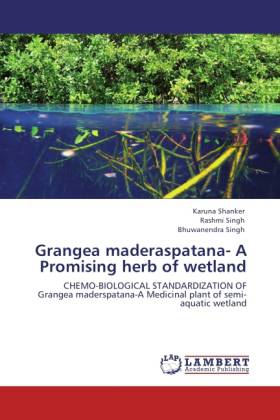
Door een staking bij bpost kan je online bestelling op dit moment iets langer onderweg zijn dan voorzien. Dringend iets nodig? Onze winkels ontvangen jou met open armen!
- Afhalen na 1 uur in een winkel met voorraad
- Gratis thuislevering in België vanaf € 30
- Ruim aanbod met 7 miljoen producten
Door een staking bij bpost kan je online bestelling op dit moment iets langer onderweg zijn dan voorzien. Dringend iets nodig? Onze winkels ontvangen jou met open armen!
- Afhalen na 1 uur in een winkel met voorraad
- Gratis thuislevering in België vanaf € 30
- Ruim aanbod met 7 miljoen producten
Zoeken
Grangea Maderaspatana- A Promising Herb of Wetland
CHEMO-BIOLOGICAL STANDARDIZATION OF Grangea maderspatana-A Medicinal plant of semi-aquatic wetland
Karuna Shanker, Rashmi Singh, Bhuwanendra Singh
Paperback | Engels
€ 48,45
+ 96 punten
Omschrijving
Biodiversity of wetlands plants constitute an integral component of any aquatic/semi-aquatic ecosystem. They not only provide shelter but also serve as a source of food. Some of them may be Some weeds are a nuisance because they have thorns or prickles, have some chemicals that cause skin irritation or are hazardous if eaten. The rich and fascinating biomass in wetland constitutes a resource of great economic, cultural, ecological and several other significant values to human life. Numbers of plants of wetland are economically useful in providing medicinal and aesthetical values and may serve as good source of fertilizer. Grangea maderaspatana is wildly grown in semi aquatic land and categorized as weed. It is widely distributed in the ponds, lake and river banks. Recently, it has attracted the attentions of natural product chemists. Numbers of its folklore claims are reported. The scientific validation is still lacking. It is part of several herbal formulations used for wide range of therapeutic purposes. This work is of fundamental importance for the persons interested to explore ethano-pharmacological studies on this plant.
Specificaties
Betrokkenen
- Auteur(s):
- Uitgeverij:
Inhoud
- Aantal bladzijden:
- 104
- Taal:
- Engels
Eigenschappen
- Productcode (EAN):
- 9783846530702
- Verschijningsdatum:
- 31/01/2012
- Uitvoering:
- Paperback
- Formaat:
- Trade paperback (VS)
- Afmetingen:
- 152 mm x 229 mm
- Gewicht:
- 163 g

Alleen bij Standaard Boekhandel
+ 96 punten op je klantenkaart van Standaard Boekhandel
Beoordelingen
We publiceren alleen reviews die voldoen aan de voorwaarden voor reviews. Bekijk onze voorwaarden voor reviews.











